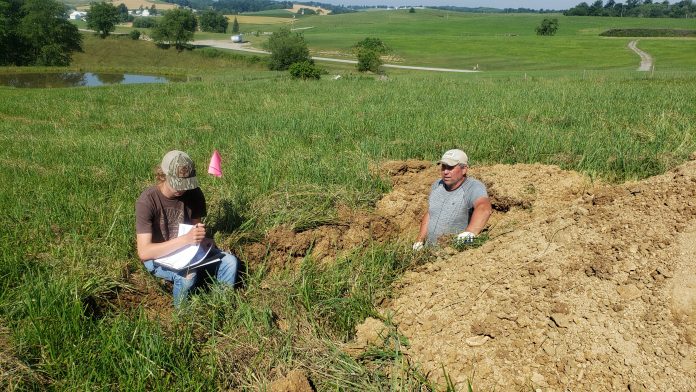
So … what are you doing?
I’ve heard it many times, and my husband, who is a soil scientist, hears it almost daily. I spent a day recently tagging along with him as he did various soil evaluations for septic system installations.
The “soils guy” is a mystery to most. Here’s a tip for you: Never arm-wrestle a soil scientist if they dig their own test holes. They have to twist a soil auger to 50” deep, and usually dig three holes per lot — for the record I can twist it to about 3”.
Some county health departments require backhoe pits be dug for an evaluation, and some are okay with using hand-dug soil augers or soil probes to look at the soil profile.
Soil evaluation
Scheduling the soils guy is one of the steps to installing a septic system; some county health departments may have someone on staff who can do this too. A soil evaluation is required for new or replacement septic systems.
The evaluator is looking at soil type (whether it’s sand, silt, or clay), limitations (called a fragipan, which acts as a barrier that water can’t penetrate), slope, and depth to perched seasonal water table. The soil scientist then tags off his report to the county health department for its blessing.
Then a septic system designer uses the info to determine which system is appropriate for the site. The size of the house and number of bedrooms also control the size of the system.
Unfortunately, wells and septic systems are an afterthought to some home builders, as are soil considerations for home sites in general.
A septic system needs to be in undisturbed, native soil. The proper order for a rural homebuilder should be to determine the site of the well and the septic system, and then site the house and garage. The area for the septic system should be flagged off so that it doesn’t get compacted. Generally, compacted soil can’t be used for the most cost-effective leach field system — pore spaces in the soil are key to proper functionality.
Not forever
Many homeowners don’t understand that septic systems are not a one and done. Because they have ponied up thousands of dollars to have it installed, they think it will work maintenance-free forever. But that’s not the case.
An EPA study several years ago determined that 30% of septic systems are failed. There are approximately 628,000 septic systems in the state. That’s a lot of potential for water contamination from harmful bacteria and pathogens.
According to the EPA, most septic systems fail because of inappropriate design or poor maintenance. Some soil-based systems (those with a drain field) are installed at sites with inadequate or inappropriate soils, excessive slopes, or high ground water tables. These conditions can cause hydraulic failures and contamination of nearby water sources.
These reasons are why the Ohio Health Department now requires a soil evaluation prior to system installation. Failure to perform routine maintenance, such as pumping the septic tank generally at least every three to five years, can cause solids in the tank to migrate into the drain field and clog the system.
The EPA has a good website for the septic system owner: epa.gov/septic/how-care-your-
Many county health departments have a grant program to help fund a system replacement. If you suspect your system is failing, contact your local health department for guidance.
Soil and water conservation districts are all about clean water and healthy soil. Although not directly involved in septic system installation, your local conservation district can provide soil information or assist you with using websoilsurvey.nrcs.usda.gov if you need it. This is a very useful site — users can define an “Area of Interest” and see the soil types, descriptions, and limitations for a list of uses.
Many county GIS websites also have a soils layer that you can view. This information doesn’t take the place of an onsite evaluation, but it’s a good idea to check before purchasing property or starting construction to learn about possible soil limitations.
Soil is probably the least valued of our natural resources, but we need it for everything, including the not so glamorous — but vitally important — septic system.












